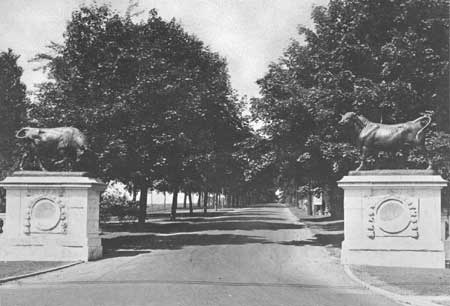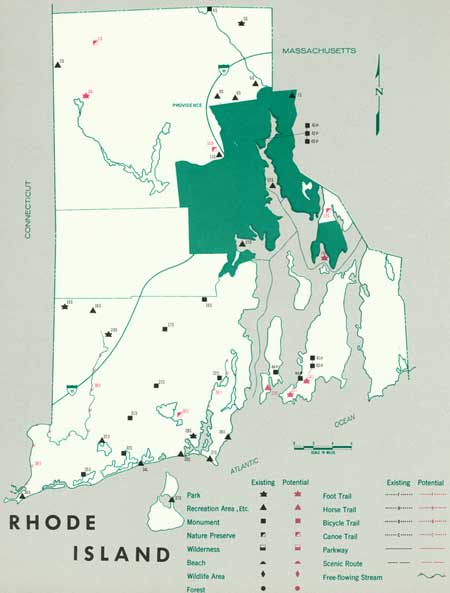.gif)
Parks for America
MENU
|
Parks for America
|

|
RHODE ISLAND
RHODE ISLAND has a great number of historic sites and other points of interest, including a notable coastal region.

|
| Touro Synagogue, gem of colonial religious architecture, typifies Rhode Island's wealth of historical associations, and of private programs to conserve them. The synagogue, in Newport, is a national historic site in non-Federal ownership. |
In 1960 it had the highest average population density in the Nation—812 per square mile. Eighty-six percent of the State's population of 859,000 lived in urban areas. Projections indicate the population may reach 1,056,000 by 1976.
The small size of the State, density of population, and development, plus limited recreation resources, combine to emphasize the importance of the Interstate System for access to neighboring States having a wider range of recreation resources.
Ocean shoreline with sandy beaches and vertical rockbound cliffs, scattered ponds, lakes, and wooded hills constitute the major recreation resources. Mild summer temperatures along the coast, coupled with a reasonably pleasant weather pattern, have contributed to the State's popularity as a resort center. A rich historical background includes the colonial and revolutionary themes and the cultural evolution of colony and State. Five sites, not in the National Park System, possess exceptional value in commemorating the history of the United States.
LOCAL: One nonurban area of 15 acres.
QUASI-PUBLIC AND PRIVATE: Seven historic monuments of national or State significance are open to the public.
PRIVATE ENTERPRISE: A highly developed and important role is played by private enterprise, which provides seashore resorts, boat marinas, and commercial tourist attractions.
EXISTING PUBLIC AREAS
STATE: The Division of Parks and Recreation administers 19 parks and recreation areas, with 8,071 acres, and 8 historic sites totaling 153 acres that had an attendance of 2,587,330 in 1960. In addition, this agency manages 31 roadside picnic areas. Nine areas totaling 14,404 acres are administered by the Division of Forests. The Division of Fish and Game has 11 areas totaling 5,943 acres and 27 fishing access sites.
PARK AND RELATED NEEDS
The high density of population coupled with the small size of the State are factors which influence recreation needs. The most pressing need is areas for nonurban recreation near enough for day and weekend use. Continued research and development is needed if full advantage is to be derived from the State's interesting and significant historical resources.
Existing State parks and recreation areas provide 8,224 acres for 859,000 residents. Potential State areas identified in this plan total 2,835 acres. Assuming that all these identified potential areas are established and developed, there will still be a need by 1976 for more State and local parks.

|
| Entrance to the Colt Estate in Bristol, R.I. |
RECOMMENDATIONS
Existing recreation resources and many potential areas are shown on the accompanying tabulation and map. If acted upon promptly, the following recommendations may help to provide needed outdoor recreation opportunities in Rhode Island.
STATE: Enlargement of the State park system to preserve significant resources by addition of three parks, and a major addition to one existing area. Further study of two suggested areas and two streams.
Supporting recommendations include—
1. Initiation of legislation aimed toward halting pollution of streams and shoreline.
2. Provide an adequate system of public marinas, sheltered anchorages, small campgrounds, and provisioning stations along established water routes in Narrangansett Bay.
3. A survey of archeological and historic sites with a view toward preservation and development.
(Table omitted from online edition)

|
| (click on image for an enlargement in a new window) |
NEXT >>>
|
|
Last Modified: Mon, Sep 6 2004 10:00:00 pm PDT
parks_america/rhode_island.htm
 Top
Top